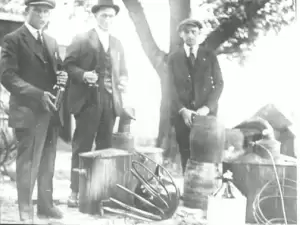The Bust

By August 1925, the Florida East Coast Railway was overwhelmed by the demands of passengers and freight, which interfered with its ability to maintain its equipment properly. The railroad placed an embargo on non-perishable goods, and by winter, at least 7,000 freight cars sat in Jacksonville, waiting to head south.
As news of real estate scams by con artists reached the North, panicked investors there cancelled their long-distance real estate contracts. In the early fall, Florida Governor John W. Martin led a delegation to New York to fight the flow of bad publicity. They held a seminar, “The Truth About Florida,” at the Waldorf-Astoria Hotel, owned by T. Coleman du Pont, an investor in Addison Mizner’s development of Boca Raton in southern Palm Beach County. One week later, du Pont and several other board members left Mizner Development Corporation.
Although imagined values started the fall of Florida’s boom, very visible events brought more tragedy to Palm Beach County. First, on September 18, 1926, a hurricane from Miami moved across the west side of Lake Okeechobee, killing more than 390 people and taking its toll on the farms of the Glades communities, as well as those along the east coast.
Because of the destruction caused by the 1926 hurricane, potential buyers were afraid to purchase land, and developers went broke. On March 15, 1927, The New York Times reported: “Three banks in Palm Beach County failed to open their doors this morning [in West Palm Beach, Lake Worth, and Delray], bringing the number closed in the county in the last week to six, and causing runs on the two largest banks still open in West Palm Beach.”
By the next day, rumors had already spread in West Palm Beach that the U.S. Government had gone broke too. About 400 owners of savings accounts at the West Palm Beach Post Office, mostly from the black community, withdrew their funds of up to $2,500 each, the maximum of post office accounts. The New York Times called it the first run in Post Office history. But the worst was still to come.
On September 16, 1928, a Category 4 hurricane, with winds reaching 150 miles per hour, destroyed 8,000 homes and hundreds of commercial buildings in Palm Beach County. Although coastal areas sustained extensive property damage, it was flooding from Lake Okeechobee and high winds that killed more than 3,000 people, most of them migrant farmers and laborers from Belle Glade, Pahokee, and South Bay.
By the time the New York Stock Exchange crashed in October 1929, sending the nation into the Great Depression, southeast Florida was in a depression of its own. From 1929 to 1930, the recorded value of all real estate in West Palm Beach dropped 53 percent to $41.6 million; by 1935 it was down to $18.2 million, little more than its pre-boom value.
The boom left behind a developing infrastructure of highways, transportation, hotels, commercial buildings, and homes. Several new hotels had opened before the hurricanes of 1926 and 1928 struck. Even before the stock market crash of 1929, several declared bankruptcy, searched for new investors, or changed names and management. Others were sold, including the Whitehall Hotel in June 1929, for $2,600 plus its $3 million of debt.

Although still operating, the Seaboard Air Line Railway declared bankruptcy in 1930. The same year, a new depot was built for the Florida East Coast Railway, which followed Seaboard into bankruptcy in 1931. Both companies were managed by court-appointed receivers for many years. Despite all these problems, the private sector in Palm Beach continued to build new houses.
Whitehall Hotel
Long after Henry Flagler’s death in 1913, his residence, Whitehall, received a ten-story addition that opened as the Whitehall Hotel on New Year’s Eve, 1927. The Post described its atmosphere as an “apartment hotel” and more formal than the Royal Poinciana Hotel, with dining and dancing in its beautiful Jardin Royal by the lake. When Flagler’s heirs converted Whitehall to the Flagler Museum, most additions were demolished.
The Depression
Zell Davis, who served as state’s attorney from 1968 to 1972, first lived on 21st Street in Riviera Beach, near his Bahamian relatives. While others sank into poverty in the late 1920s, Davis’ family prospered as bootleggers during Prohibition. Davis moved to a large house on 35th Street in West Palm Beach in 1931, when he was five, and remained aware of his good fortune during the Depression years as he recounted in a 2004 oral history interview:
I would go up on the weekends to Riviera Beach and see some of my cousins and see my grandparents. … All of those families I knew up there were on the dole [welfare]. The truck would come sometimes when I’d be up there visiting and they’d say, “Come on out to the highway and help us carry the stuff in.” There would be bags of prunes and flour and sugar and all sorts of stuff like that. They were very, very poor. … Clothing, anything I’d outgrown, my mother would always take it up and it would be distributed. Christmas time, we would load up our car and take baskets of fruit and presents up to all those people in the neighborhood.
Zell Davis
Jupiter
The Town of Jupiter felt the bust sooner than other parts of Palm Beach County. In 1925 the town made plans to establish zoning of residential and commercial areas and add plazas, a yacht club, and a civic center. The following year, street lights were installed, and a water system to accommodate a population of 500. But by 1927 the town needed a short-term loan to pay for the lights, and residents requested that some be left un it to reduce expenses. When many property owners did not pay their taxes, the town at first seized the land, and then repealed the tax ordinance for the year.

